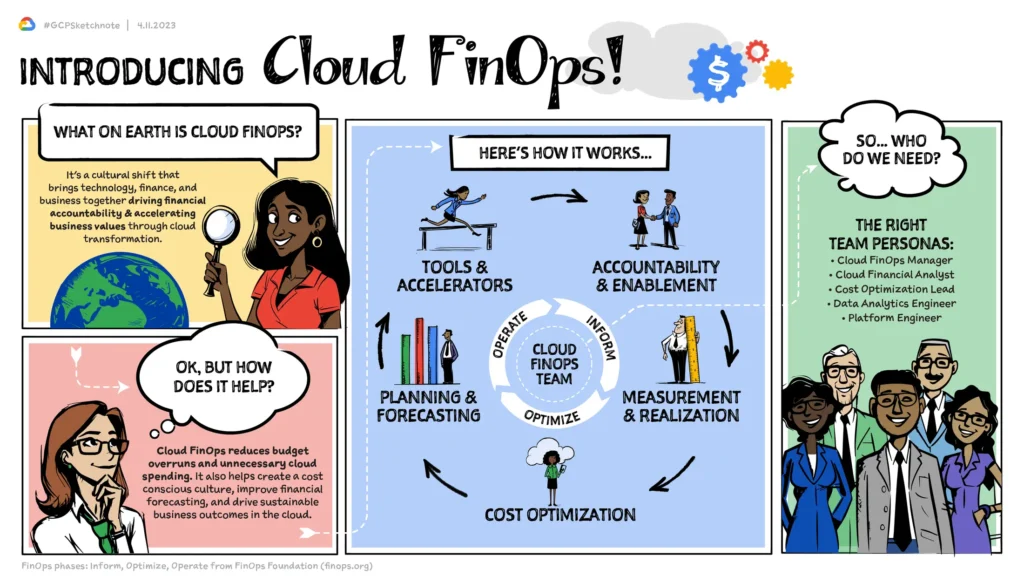Artificial intelligence and its accompanying technologies are transforming FinOps into a smart approach to data management and efficiency.
Artificial intelligence, through machine and predictive analytics, offers firms more precision in the analysis of financial data; outlooks on future budgets; and tracking, in real-time, exactly what is being spent.
With automation and the discovery of latent insights, AI enhances the accuracy and efficiency of financial management in making improved financial decisions and controlling costs for businesses.
An executive architect’s approach to finops: how AI and automation streamline data management
In this article, I am going to answer how AI and automation streamline data management with a FinOps executive architect’s approach to, among other things, associated challenges.
Overview Of FinOps
FinOps stands for Financial Operations. It’s a practice at the junction between financial management and operational excellence.
It focuses on maximizing business value while effectively managing cloud cost expenditure and optimizing financial performance by bringing people, processes, and technology together.
FinOps promotes a collaborative approach between finance, engineering, and business teams to ensure that financial decisions are made against a complete comprehension of their effects on general business operations.
FinOps is dynamic cloud financial management that certifies organizations to maximize business value through collaboration between the engineering, finance, technology, and business teams.
Here, FinOps focuses on data-driven spending decisions to ensure cloud data management remains relevant.
FinOps is the strategic mandate of teams for the management of effective cloud cost management and bridging the gap to core practices. It reinforces ownership of cloud usage within LOBs while being supported by a central group that maintains best practices.
Cross-functional engineering, finance, CRM, and product teams work in cooperation to drive faster delivery while ensuring greater financial control and predictability.
Role of FinOps in Business Strategy
FinOps forms part of modern business strategy through the balancing of financial management against business goals via collaboration that drives efficiency.
FinOps is part of modern business strategy because it offers tools and practices for the effective management of financial operations.
FinOps can help organizations in achieving their financial objectives and maintaining a competitive advantage in today’s dynamic marketplace by enabling improved visibility, collaboration, efficiency, strategic decision-making, and growth.
Key Role of FinOps in Business Strategy
☑️ Enhancing Financial Visibility and Control
👉🏼 Cost Transparency: FinOps provides excellent visibility of spending in the cloud and allows a business to understand where money is spent and where cost-saving opportunities lie.
👉🏼 Budget Management: FinOps ensures budgets are adhered to by monitoring expenses in real-time, allowing the allocation of financial resources accordingly.
👉🏼 Predictive Analytics: FinOps uses data to predict future spending and thus help in more accurate planning while avoiding surprise costs.
☑️ Fostering Collaboration Across Teams
👉🏼 Cross-functional Teams: FinOps fosters cooperation among finance, engineering, technology, and business teams, thus allowing every employee to know exactly the organization’s financial objectives.
👉🏼 Unified Objectives: The interaction of different departments in FinOps leads to a comprehensive financial understanding and fosters leading a financially responsible course.
☑️ Driving Operational Efficiency
👉🏼 Optimizing cloud use: FinOps practices ensure that the cloud resources being used in an organization are efficiently utilized, and a lot of potential wastage could be reduced along with maximizing the ROI on cloud services.
👉🏼 Automation: FinOps reduces manual work by implementing an automated process for monitoring and managing cloud expenses, increasing efficiency.
👉🏼 Scalability: FinOps enables scaling cloud usage efficiently so that businesses can adjust to demand without overspending.
☑️ Supporting Strategic Decision-making
👉🏼 Data-driven insights: FinOps empowers great insights from the analysis of data, which enables informed decisions at any organizational level.
👉🏼 Agility: FinOps empowers organizations to respond with speed to the changing markets by means of real-time data and predictive analytics, and it gives the ability to pivot strategies whenever necessary.
👉🏼 Risk Management: FinOps helps to identify very early the warning signs that may suggest a likely financial risk and develop ways to mitigate it, ensuring financial stability.
☑️ Enabling Innovation and Growth
👉🏼 Resource Allocation: FinOps ensures that financial resources are invested in only those projects with very high return potential, thereby encouraging innovation and business growth.
👉🏼 Investment in Technology: FinOps enables businesses to invest in new technologies and innovations that offer a competitive edge through effective cost management.
👉🏼 Continuous Improvement: FinOps promotes continuous improvement by encouraging teams to seek ways of optimizing spending and improving financial performance continuously.
Key Components of FinOps
This implies knowing the key elements that FinOps executives and businesses play in the management of their financial operations, leading to better overall financial performance of the business.
Key components are –
✅ Cost Management
🟢 Monitoring and Optimization: This involves the regular tracking and analysis of cloud spending for the identification of inefficiencies and leveraging cost-saving opportunities. Continuous monitoring will help facilitate real-time adjustments and ensure that the cloud resources are put to good use.
🟢 Resource Allocation: This is the effective allocation of monetary resources across various projects and departments, considering their needs and potential returns. Ensuring that the most critical areas are adequately funded to execute business imperatives.
Next up is cost transparency; it allows the stakeholders to have a clear indication of the spending patterns and the available trends, which is a critical element underpinning fiscal accountability. Transparent cost reporting enables the stakeholders to know where their money is used and hence make well-informed decisions on how to allocate resources.
✅ Budget Forecasting
🟢 Predictive Analysis: Assists organizations in effective planning with the use of historical data and artificial intelligence tools to predict future financial needs and trends. In this way, with predictive analysis, the cost planning process will be more anticipatory with a strategic budget.
🟢 Scenario Planning: The preparation of various financial scenarios keeps any business ready for different market conditions and their associated problems. Scenario planning helps draft solid strategies that can adapt to changes and uncertainties.
🟢 Resource Planning: Budgetary forecasts are aligned with business goals and operational plans to ensure appropriate funding to important initiatives. Effective resource planning ensures that financial resources are available for strategic priorities.
✅ Financial Accountability
🟢 Stakeholder Collaboration: Teams from finance, engineering, and business will be put to work in collaboration on common financial goals, so that all parties get setup and start working efficiently with respect to the management of their finances.
🟢 Performance Metrics: Setting up and tracking relevant KPIs to measure financial performance and operational efficiency is very important. KPIs present a clear picture regarding how well the financial goals and objectives are met and where improvements are needed.
🟢 Reporting and Compliance: A core aspect is ensuring proper and timely financial reporting for regulatory requirements and providing insights to stakeholders. Compliance with the regulation of finances prevents litigation and goodwill erosion.
Role of an Executive Architect in FinOps
An Executive Architect is important in the successful implementation and running of FinOps within an organization.
The executive architect’s roles include strategic oversight, technical guidance, and cross-functional collaboration to ensure that financial operations are optimized toward business objectives.
The role of an Executive Architect in FinOps combines strategic oversight, technical guidance, and cross-functional collaboration.
The Executive Architect leads in integrating FinOps practices to ensure that financial operations are optimized with respect to business objectives, driving efficiency, and fostering innovation.
This has been a critical position in realizing financial accountability to remain competitive in the dynamic business environment.
Key roles of an Executive Architect in FinOps include:
✅ Strategic Oversight
🟢 Vision and Leadership: The Executive Architect defines the vision by which FinOps practices would be integrated into the Organization. This would be exercised through leadership in aligning FinOps strategies to meet overall business goals and ensuring that financial management operations are supportive of the company’s long-term objectives.
🟢 Policy and Governance: This involves a very critical responsibility of setting up policies and governance frameworks around the same. The Executive Architect shall ensure that clear guidelines on financial operations are instituted, promoting consistency and compliance across all teams.
🟢 Performance Metrics: They define and track key performance indicators that would help measure the success of FinOps initiatives. Monitoring these metrics constantly helps the Executive Architect to drive continuous optimization by identifying areas for improvement.
✅ Technical Guidance
🟢 Technology Selection: The Executive Architect selects appropriate tools and technologies that support FinOps practices. He evaluates software for cost management, budget forecasting, and financial reporting.
🟢 Data Integration: As a function, the Executive Architect ensures seamless integration of the financial data available across different systems. He will oversee the implementation of data integration solutions that provide a single view of financial information for accurate analysis and decision-making.
This might involve automating the financial process. The Executive Architect will identify opportunities where automation can enhance efficiency, reduce manual errors, and smoothen financial operations.
Cross-functional Collaboration
🟢 Team Alignment: The Executive Architect promotes collaboration across the finance, engineering, technology, and business teams. It is by promoting this culture of teamwork that he ensures all departments are aligned to the organization’s financial objectives.
🟢 Training and Development: Any team member must be provided with training and development in the process of performing his duties. The Executive Architect ensures that individuals relevant to this are knowledgeable about FinOps practices and have enough capability to enforce them effectively.
🟢 Stakeholder Communication: This role entails clear and effective communication with stakeholders. That amplify stakeholders are kept updated on FinOps-related matters about the initiatives, progress, and outcomes to ensure transparency and accountability at all levels.
✅ Optimization and Innovation
🟢 Continuous Improvement: The executive architect ensures a culture of continuous improvement driven through the organization. He periodically reviews and refines FinOps practices to bring out the best both in terms of financial performance and operational efficiency.
🟢 Innovation: Keeping up with emerging technologies and FinOps trends is totally not a one-time task. The Executive Architect keeps a lookout for new innovations and continues to assimilate those cutting-edge solutions that will help him maintain a lead over others in financial operations.
It is a critical responsibility that comprises activities of risk identification and mitigation. The Executive Architect does several things to be able to manage risks effectively so that the organization remains financially stable.
The Executive Architect’s Approach To Finops
An Executive Architect’s approach to FinOps involves centralizing financial operations optimization and ensuring alignment of cloud investments with business goals.
The Executive Architect maintains a strategic oversight role in providing technical guidance and facilitating collaboration in the presence of common difficulties in financial operations.
This way, through the Executive Architect, such challenges can be offset by effective policies, tools, and practices to ensure that financial operations are optimized toward supporting business goals and driving organizational success.
See how the approach of an executive architect can effectively face these challenges.
☑️ Strategic Oversight
Vision and Leadership: The Executive Architect sets a strategic direction in which FinOps should head, ensuring that practices for the management of finances support the long-term objectives of the organization. By aligning strategies in FinOps with the goals of the business, they provide clear vision and leadership to drive financial success.
✔️ Policy and Governance: The establishment of robust policies and governance frameworks is one of the most important steps towards consistency and compliance of financial operations. The Executive Architect will ensure that well-defined guidelines pertaining to the proper management of finance across the Organization are implemented.
✔️ Performance Metrics: A set of KPIs is defined and tracked to measure the effectiveness of the FinOps initiative. The Executive Architect checks the progress against such metrics, works out areas of improvement, and drives continuous optimization.
☑️ Technical Guidance
✔️ Technology Selection: An Executive Architect would select the proper tools and technologies for cost management, budget forecasting, and financial reporting, and implement them. He evaluates and chooses solutions that best support the FinOps goals of an organization.
One of the integral responsibilities is to ensure seamless integration of financial data across different systems. The Executive Architect manages data integration programs for a single view of financial information, which would mean proper analysis and informed decision-making.
✔️ Automation: One such area that would be central to this process is implementing automation that will help smoothen financial processes. The Executive Architect identifies opportunities where automation can enhance efficiency, reduce manual errors, and improve the entire set of financial operations.
☑️ Cross-functional Collaboration
✔️ Team Alignment: The Executive Architect works with the finance, engineering, technology, and business teams in running the practice. Putting in place a culture of collaboration and alignment, the Executive Architect drives all teams toward common financial goals.
✔️ Training and Development: Offer training and development opportunities to empower personnel from the teams regarding FinOps practices; in other words, the Executive Architect ensures that the relevant personnel are competent and ready to implement and manage FinOps.
✔️ Stakeholder Communication: The stakeholder communication should always be transparent and effective. The Executive Architect takes measures to ensure that FinOps initiatives, progress, and outcomes are very transparent and communicated to all parties. This embeds transparency and accountability.
☑️ Optimization and Innovation
✔️ Continuous Improvement: The Executive Architect drives a culture of continuous improvement, whereby he reviews and refines FinOps practices for better financial performance and operational efficiency.
✔️ Innovative: Be up-to-date with new and emerging technologies and trends. The executive architect has the mandate to find and further innovate solutions that keep pace with competition in financial operations.
✔️ Risk Management: One of the fundamental principles of your role will be identifying and mitigating financial risk. The executive architect will design strategies for managing risks that will sustain the stability of the organization’s finances.
Challenges Associated With FinOps & What Are Solutions to It
Of course, there are several challenges associated with FinOps that need to be constantly monitored, and proposing new and innovative solutions to the challenges.
By proactively addressing these challenges with targeted solutions, organizations can enhance their FinOps practices, improve financial management, and support overall business objectives effectively.
Among many, here are few of the challenges associated with FinOps and their solutions as well-
Cost Visibility and Control
🔴 Challenge: Managing and tracking expenses across complex cloud environments can obscure visibility and control over costs.
🟢 Solution: Implement comprehensive cloud cost management tools that provide real-time visibility and detailed reporting. Establish clear tagging and categorization practices to track expenses accurately. Regularly review spending and adjust budgets as necessary.
Budget Forecasting
🔴 Challenge: Predicting cloud costs can be inaccurate due to fluctuating usage patterns and changing business needs.
🟢 Solution: Use advanced forecasting tools that leverage historical data and machine learning to improve accuracy. Create flexible budgeting models that can adapt to varying usage scenarios. Regularly update forecasts based on current data and trends.
Data Integration
🔴 Challenge: Financial data is often siloed across different systems, making integration and unified analysis difficult.
🟢 Solution: Implement data integration platforms or APIs that unify financial data from various sources. Standardize data formats and ensure consistent data quality to facilitate smoother integration. Regularly audit and clean data to maintain accuracy.
Automation Challenges
🔴 Challenge: Setting up and managing automation tools can be complex and prone to errors.
🟢 Solution: Start with pilot projects to test automation tools before full-scale implementation. Ensure thorough configuration and regular monitoring to catch and address errors early. Provide training to teams on managing and troubleshooting automated systems.
Cross-functional Collaboration
🔴 Challenge: Misalignment and communication barriers between finance, engineering, and other teams can hinder effective FinOps practices.
🟢 Solution: Foster a collaborative culture by holding regular cross-functional meetings and aligning team goals with FinOps objectives. Use collaboration tools to facilitate communication and ensure all teams are informed and engaged.
Change Management
🔴 Challenge: Resistance to adopting new FinOps practices or tools can slow down implementation.
🟢 Solution: Engage stakeholders early in the process to gain buy-in and address concerns. Provide comprehensive training and support to ease the transition. Highlight the benefits of new practices to encourage adoption.
Performance Measurement
🔴 Challenge: Defining and tracking relevant performance metrics for FinOps can be challenging.
🟢 Solution: Work with key stakeholders to identify and define meaningful KPIs that align with business objectives. Use performance dashboards and reporting tools to track and analyze metrics regularly. Adjust KPIs as needed based on evolving business needs and goals.
Risk Management
🔴 Challenge: Identifying and mitigating financial risks associated with cloud spending and operations can be complex.
🟢 Solution: Implement risk management frameworks and regularly conduct risk assessments. Use predictive analytics to identify potential financial risks early. Develop and test risk mitigation strategies to address identified risks.
Compliance and Governance
🔴 Challenge: Keeping up with regulatory requirements and enforcing consistent financial policies can be difficult.
🟢 Solution: Stay informed about relevant regulations and ensure that FinOps practices are aligned with compliance requirements. Develop and enforce clear governance policies, and conduct regular audits to ensure adherence.
How AI And Automation Streamline Data Management ?
Now let’s see how AI and automation make data management easier.
AI and automation are changing the face of data management in ways that enhance efficiency, accuracy, and scalability.
AI-driven tools offer much ease in collecting data by automating the process of information gathering from various sources. This way, it eliminates a lion’s share of the manual entry, hence nearing its eradication with each progressing day.
This ensures completion and updates in datasets and, with real-time analysis of data through AI algorithms, any ground observation is possible, hence arriving at decisions more rapidly.
The other strong point on which AI operates is data quality improvement. Inconsistencies, duplicates, and inaccuracies can automatically be identified and corrected using AI systems, thus advancing the dependability of data.
Most importantly, predictive maintenance through automation tools shall predict the problem and solve it prior to creating disturbances in the data systems so that the integrity of data can be maintained.
AI and automation help to integrate the data in a beneficial manner.
The automation tools help in the proper integration of information from various sources into one single system without any manual requirements for consolidation; hence, no question of disparity in the data arises.
Enhanced Extract, Transform, Load (ETL) processes that are simplified even more for large amounts of data are derivable from automation at the levels of extraction, transformation, and loading.
Automation of scaling adaptive AI systems is derivable in that they will need to automatically adjust resources on volumes and processing needs.
This makes the data management systems possible to scale and always be effective when the data load is increased.
Beyond that, AI and automation allow for seamless integration with the cloud, enabling flexible and scalable data handling capabilities.
AI takes the capability of data analytics even further by using machine learning models to uncover patterns or trends in data that other methods may not reveal.
NLP takes this further and makes it more accessible by allowing users to query data and generate reports with the help of natural language.
The application of AI and automation also strengthens any implementation from security and compliance perspectives. Artificial intelligence perpetually watches the data systems against any slight threats to the security and compliance. It also quickly alerts and responds in real time in case of any possible violation or breach.
With the use of automation tools, compliance reports can also be generated to ensure conformity with industry regulations and standards.
Cost efficiency, on the other hand, improves, considering that reduced manual efforts and optimized use of the resources are bound to happen.
Automating routine tasks in data management can lead to a reduction in operational costs, with the workforce consequently focusing on higher-order activities.
Optimization driven by AI leads to better utilization of resources and makes operations associated with data management less wasteful and more cost-efficient.
AI with automation changes data management with its advanced capabilities in processing efficiency, quality, and security to get better and cheaper.
In Brief Point :
✔️ Enhanced Efficiency: AI automates data collection and real-time data analysis, reducing manual effort and increasing the speed of decision-making.
✔️ Better Quality Data: AI discovers inconsistencies in data and corrects them; predictive maintenance tools avoid problems within the system.
✔️ Smooth Integration of Data: Automation combines data from various sources into one unified system and optimizes ETL processes.
✔️ Scalable Solutions: AI throttles resources as per the requirement of the data and ensures effectiveness in managing growing data volumes.
✔️ Advanced Analytics: AI discovers patterns and trends with machine learning, while NLP makes the querying and reporting of data easier.
✔️ Enhanced Security and Compliance: AI monitors for threats and compliance issues; automation ensures adherence to regulations.
✔️ Cost Efficiency: Automation reduces manual labor and optimizes resource use to bring down operational cost and minimize waste.
How AI Enhances Data Management in FinOps
AI in FinOps allows the integration of advanced technologies to streamline, attain accuracy, and facilitate strategic decisions for financial operations management.
This capability would allow organizations to optimize FinOps practices to drive greater efficiency, accuracy, and strategic insight into managing financial operations.
How AI transforms data management in FinOps:
☑️ Advanced-Data Analysis
Machine Learning: AI uses machine learning to mine historical financial information, discovering trends and patterns that traditional methods are often unaware of. This leads to more accurate forecasting and budgeting due to an advanced level of understanding of spending behaviors and outcomes.
NLP allows interaction with the data using natural language queries, thus easy report generation and extraction of insights without specialized technical skills, improving accessibility and usability.
☑️ Predictive Analytics
Budget Forecasting: Predictive analytics models project future financial needs and spending patterns based on historical trends. In this way, organizations can project budget requirements and proactively make changes to financial plans to avoid potential risks associated with changes in budgets.
☑️ Real-Time Monitoring and Alerts
Cost Management: AI-driven tools track in real-time any financial data and anomalies or variances from expected spending. Through auto-generated alerts to stakeholders in case of possible budget overruns or unanticipated expenses, automated alerts facilitate prompt corrective measures and hence better cost control.
Improved Data Processing
Automated tasks in data management using AI—data entry, cleaning, integration—are aimed at reducing manual efforts and minimizing errors for consistency in finance data. Faster and more accurate processing will mean improved operational efficiency and decision-making.
FAQ Related To “ An executive architect’s approach to finops: how ai and automation streamline data management ”
❓ Which AI technologies are in use with FinOps?
Some of the AI technologies used in FinOps include machine learning, natural language processing, and predictive analytics. These tools analyze data, forecast financial trends, and enable natural language queries for easier reporting.
❓How does AI make data analysis better in FinOps?
AI enhances analysis by discovering complex patterns and trends that might otherwise elude conventional analysis. Machine learning models and NLP help in gaining deeper insights and making precise financial decisions.
❓What is predictive analytics in FinOps?
Predictive analytics uses historical data and machine learning algorithms to predict future financial outcomes and budget needs. Therefore, it allows budget planning and risk management proactively.
❓How does AI enable real-time monitoring in FinOps?
AI tracks financial data in real time, detecting aberrations and unusual spending patterns. Automated alerts to the user enable concerned authorities to take quick corrective actions for better cost management.
❓In what ways does AI enhance data processing in FinOps?
AI automates tasks concerning data entry, cleansing, and integration, saving manual effort and associated errors. This improves data accuracy, consistency, and processing efficiency, hence making financial management more reliable.
❓ What are the benefits of using AI in FinOps?
Among others, benefits include improved accuracy in forecasts and budgeting, real-time cost management, better data quality, and more efficient processing of data—all aimed at enabling financial decisions to be made properly.


![Vizard AI Alternatives : Streamlined Video Editing [ Sites Like Vizard AI ] By Simplified Lab AI or SimplifeidLab.com](https://simplifiedlab.com/wp-content/uploads/2024/08/Blue-Halftone-Secret-Tips-Social-Media-Tutorial-YouTube-Thumbnail-5-150x150.jpg)



